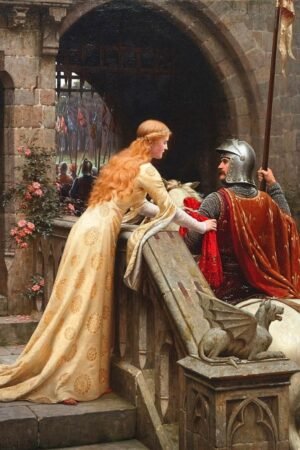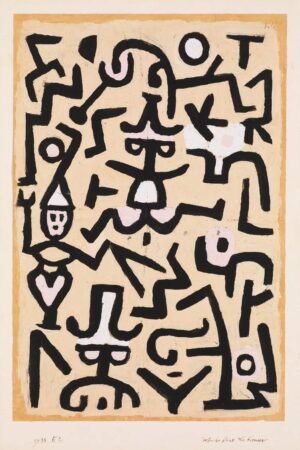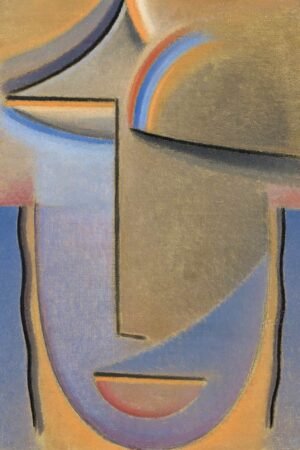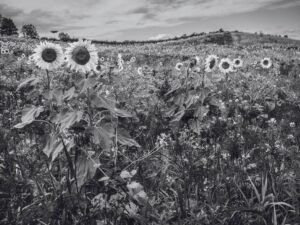The Famous Works, Legacy, and Life of Van Gogh
The Dutch painter Vincent van Gogh is one of the most recognized names in the art world and beyond, reflected in the amazing amount of posthumous literature about him and the mind-boggling prices his work sells for now.
Yet, although he has a catalog of works amongst the most well-known of any artist, he did not achieve artistic success during his lifetime. He exhibited very little and sold very few works. Plagued with poor mental and physical health, Van Gogh spent his life as a relatively unknown artist and in poverty.
Now, we often conflate Van Gogh with the stereotype of “the struggling artist”—but there is so much more to his legacy than that. His compositions are brimming with energy, undeniable emotion, and vibrant color, and keep his artistic spirit and mind alive, and making his compositions some of the most iconic ones in the world.
Let’s explore the intriguing life of Van Gogh and explore some of his most famous works. We’ll get into some lesser-known Vincent van Gogh facts along the way, too, to try and paint a complete portrait of the famous Dutch artist.
Browse our collection to buy van gogh’s best known and unique works: Van Gogh Art Prints
The Life of Van Gogh: The Early Years
Van Gogh was born in 1853 in Groot-Zundert, Netherlands, to a middle-class family. His mother, Anna, was an amateur artist who was passionate about nature, which she hoped to instill in her six children. His father Theodorus was a minister, a path which Vincent would initially try and follow.
Born a year after his mother gave birth to a stillborn child (who was also named Vincent) he was the eldest of six children. His younger brother, Theo, was an art dealer and a staunch supporter of Vincent, both financially and otherwise, throughout his life. Their relationship is documented through many letters over decades and form a primary source of information on the life of Van Gogh.
As a teenager, Van Gogh left school to help support his family financially, so he went to The Hague to work for his uncle’s art dealership Goupil & Cie. In 1873, he moved to the London branch of the company, prompting a fascination with English culture. However, his happy time there came to an end when he impulsively proposed to his landlady’s daughter, who promptly rejected him, triggering a mental breakdown. His attitude at work worsened and he was eventually fired—he decided to devote himself to God, keeping only his Bible.
For the next few years, Van Gogh committed his life to preaching, like his father. He taught at a boys’ school and preached to the congregation—he then tried to get accepted into the School of Theology in Amsterdam. However, he ultimately refused to take the entrance exam, since it was in Latin, which was a “dead language” in his opinion.
So, he eventually volunteered to preach in an intensely impoverished coal-mining town in Belgium (a dreaded position for preachers) where he earned the title “Christ of the Coal Mines” from the residents because of his devotion and selflessness. However, the church wasn’t happy with his lifestyle and found it to be rather martyr-like. His contract was not renewed despite his positive relationship with the community.
Although this is a bit of a lengthy biography prior to being an artist, it’s information on the life of Van Gogh that informs his later work, both in terms of subject matter and temperament.
Life as an Emerging Artist
His life dedicated to art started in 1880 at the age of 27. In letters to Theo, he sent sketches, and his brother encouraged him to focus on his artistic abilities—this was a major turning point in the life of Van Gogh (and the course of art history). He took his brother’s word and became convinced that he could also serve God as an artist.
To initiate this change in life direction, he moved to Brussels to teach himself art. He was financially supported by Theo and spent some years after as somewhat of a nomad—including moving back home with his parents, who were not as excited about this life change—as he improved his formal skills. In 1881, he moved suddenly moved out of his parents’ house to The Hague, writing to Theo,
“‘Pa cannot empathize or sympathize with me, and I cannot settle in to Pa and Ma’s routine, it’s too constricting for me — it would suffocate me.’”
Complicated Van Gogh’s direction was his constantly messy love life, which often sent him into mental tailspins. This was a constant struggle, but it heightened from 1881–1883 when he fell in love with a model named Sien, who was also a prostitute, to the immediate disapproval of his family, including Theo. He was determined to take care of her and her 5-year-old daughter, so he rented a studio for them all—eventually, he realized he needed to break it off. This provoked another nomadic period, in which he lived on and off with his parents in the Dutch countryside as well as in Paris.
While living with his parents in 1883, he began one of his first paintings that we know as a masterpiece, The Potato Eaters. This was one work among many depicting peasants. Although Theo didn’t feel that it was going to be successful in Paris, where Impressionism was in vogue, Vincent decided to move in with his brother in the French capital in 1886 after a brief stint in Belgium.
Van Gogh’s Mature Period
After moving to Paris in 1886, he interacted with artists such as Camille Pissarro and Henri de Toulouse-Lautrec—associations with these other modern artists, in part, caused his palette to become a bit lighter. However, he often bickered with other painters and alienated them.
This event was a big shift in the life of Van Gogh. His style changed while in Paris—brighter colors, vibrant still-lifes of flowers, and scenes of the Seine. By 1887, he was using pure colors in an almost pointillist style. Finally, in 1888, he developed his own signature Post-Impressionist style, which combined his earlier dark palette and style with Impressionist influences.
He tired of Paris and moved to Arles, in the south of France, where he moved into “The Yellow House.” This marked another period of productivity. He invited artist friends from Paris—such as Paul Gauguin—to stay with him. Also a temperamental person, Gauguin fought with Van Gogh, leading the latter to cut off his ear on Christmas Eve during a heated argument. Although it’s normally said that Van Gogh cut his own ear off, these is one of several questionable Vincent van Gogh facts—later investigation revealed it might’ve in fact been Gauguin.
This event was the start of a final tailspin in the life of Van Gogh. He returned from the hospital with a bandaged ear, painted some self-portraits and still-lifes, and then felt so badly about his mental health that he admitted himself to the asylum in Saint-Remy, where he stayed for 12 months. He hoped to preserve his sanity, which he felt essential for his art. While staying there, he painted some of his most famous works, including The Starry Night, characterized by a new vigor in his linework.
In May 1890, he grew so homesick that he went back to the north to see Theo and live in the countryside. He painted cornfields, cottages, and the church, and adopted a more lyrical style. He fought with his host and doctor, Dr. Gachet, and was overwhelmed with feelings of guilt towards Theo, who had been supporting him for so long. In July 1890, he shot himself, dying two days later at the age of 37. Theo died six months later.
Five of the Most Famous Works by Van Gogh
The Potato Eaters (1885)
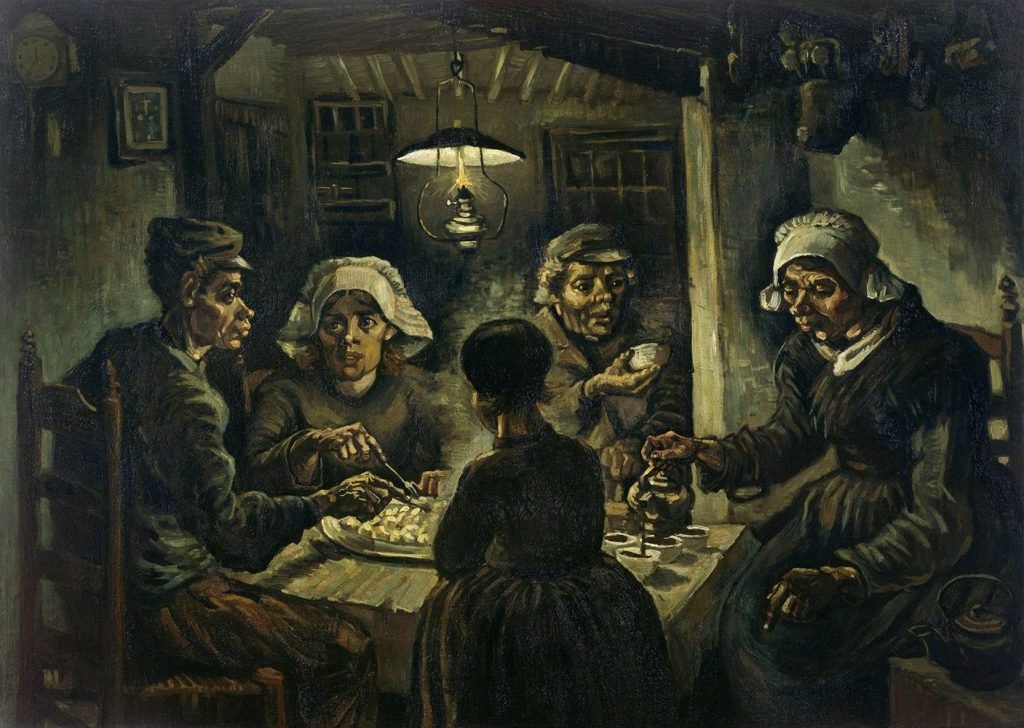
In The Potato Eaters, Van Gogh depicts a group of peasants huddled around a table. The lighting is grim, with primarily blacks, greens, and yellows, and the figures are not painted idealistically, but rather harshly. They are in a small room, tired after a day’s work, and eating their supper. The painting is not a happy one, but it is undeniably honest and you can feel Van Gogh’s desire to depict a real atmosphere.
Van Gogh hoped to prove himself capable of dealing with difficult compositions. He also wanted to depict the harsh reality of country life, as he outlines in a letter to Theo: they “have tilled the earth themselves with these hands they are putting in the dish … that they have thus honestly earned their food’.”
Although maybe this work isn’t what we necessarily immediately identify with Van Gogh, it does illustrate his core values. It is the earliest work on this list and is a painting that Van Gogh saw as a sort of showpiece—however, as we mentioned above, his brother Theo didn’t think it would gel with the art scene at the time, which turned out to be right. Critics panned it for the dark and unpleasant palette as well as the technical imperfection of the figures. Now we consider it a masterpiece.
The deeper message was most important to van Gogh—this is a common thread throughout his paintings, and is what, in part, makes them resonate with people today.
The Bedroom (1889)
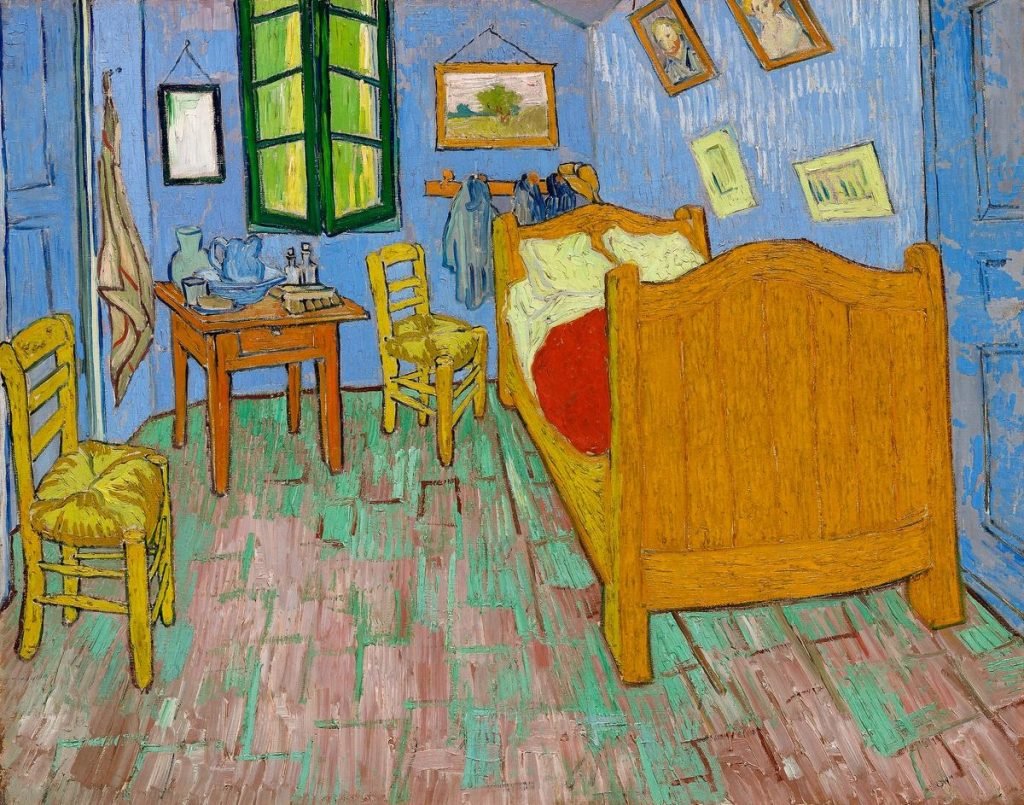
There are three different versions of The Bedroom depicting the space he lived in the “Yellow House” in Arles, France. This was one of the few times the artist lived on his own. Apparently, he was so excited to have a space of his own that he devoted himself to decorating it, which led to a nearly three-day stay in bed from exhaustion.
He then decided to paint a painting of his bedroom following this bout. Through the eyes of Van Gogh, he was painting a scene of stability, relaxation, and peace, but to many viewers, the contours of the furniture and the extreme perspective indicate turmoil and nervous energy.
Like all of Van Gogh’s paintings, it is easy to read into them in terms of his mental landscape. Here, it stands as an ode to solitude despite the rough lines and simple decor.
Starry Night (1889)

Of course, this list has to include one of the most iconic works ever The Starry Night. Painted in June 1889 in Saint Rémy, The Starry Night is a vibrant composition of blues and yellows, painted in thick swirls. The landscape was inspired by the view of the world from his window at an asylum, where he was staying for several months to cope with mental illness.
Just one thing that makes this work so interesting is that it was painted partially from memory and partially from observation, resulting in a work that is intensely emotional yet still retains the feeling of it being an actual place.
You can look online to read about all the interpretations and context of this work, but you can also just look at it and feel the energy Van Gogh’s hand put into this painting. You can imagine the way he saw the world, or perhaps wished the world looked like, or how he needed to express the inner turmoil he was feeling. Either way—you know that Van Gogh was interpreting his surroundings through an emotional lens, and that we are not just looking at an abstract landscape, but at a subjective view of his corner of the world.
Sunflowers (1889)
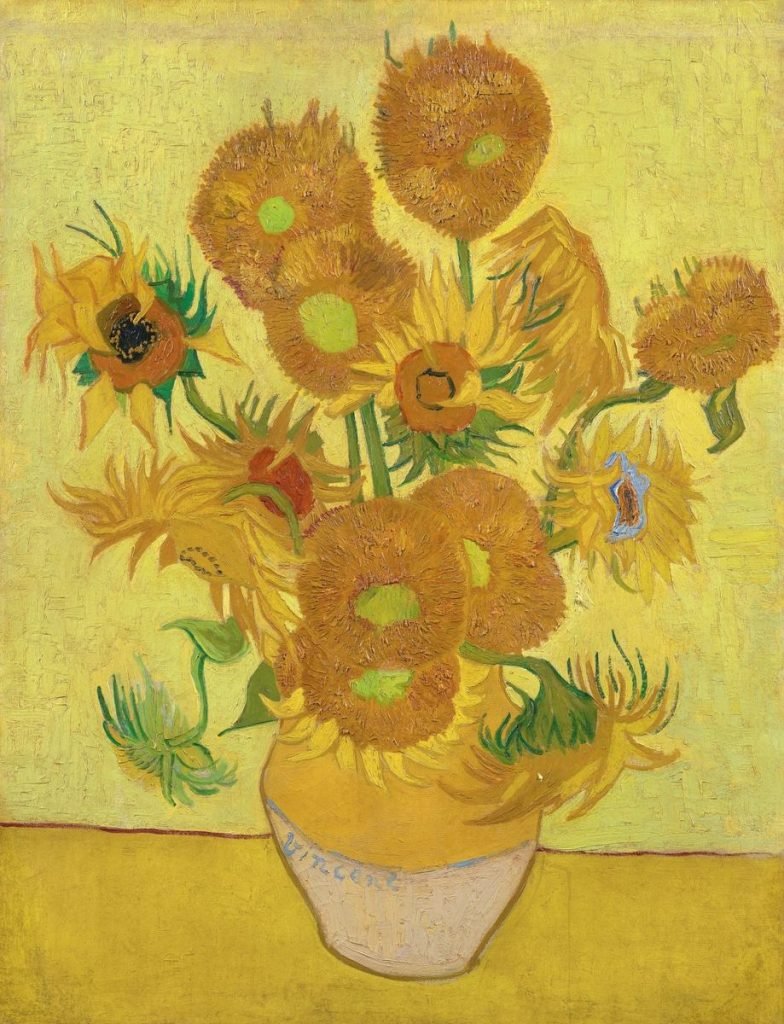
While he was in Arles, Van Gogh also painted several compositions of sunflowers. It is a straightforward subject: a vase of sunflowers sitting on a table.
He made five paintings of the subject and hoped to show that he could create vibrant and dynamic paintings from variations of a single color (in this case yellow). With each version comes slightly different energy, but all of them express the warm and pleasant energy that the flowers meant to Vincent.
In a letter, Van Gogh said that the sunflowers represented gratitude. He reportedly painted them to make the Yellow House more welcoming to his friend Paul Gauguin who was going to be staying with him.
Sunflowers has also gained widespread press because of questions regarding authenticity. As Van Gogh made several copies, each painting’s provenance (or history of ownership) has been up for speculation. Specifically, a version of Sunflowers that surfaced in a Japan auction was thought to be a fake—we still don’t know the answer today. The short life of Van Gogh and his lack of inventory make his work a prime victim of modern fakes.
Self-Portrait (1889)
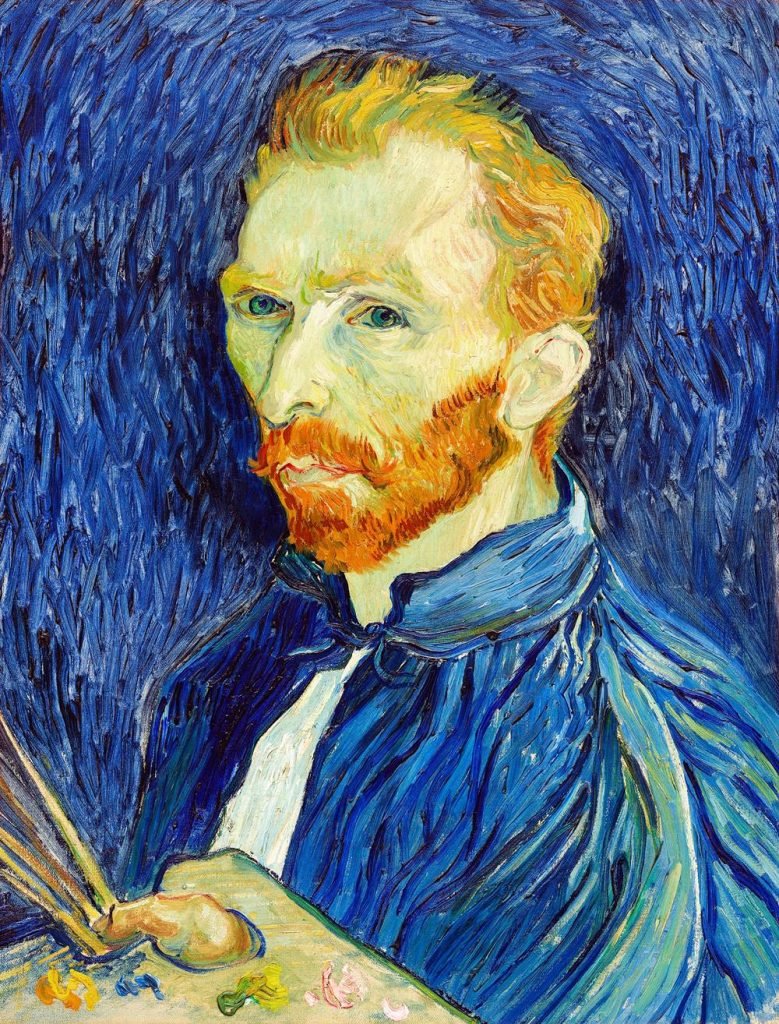
The life of Van Gogh is plagued with self-identity and confidence issues—this makes his self-portraits all the more interesting to look back on in a biographical sense. Considering Vincent van Gogh facts that we’ve learned since his death provides tons of insight into his short life and his work.
Throughout his life, he made over 35 self-portraits. However, this practice wasn’t an exercise in vanity, but one of necessity; as he was learning how to paint, he didn’t have enough money for models, so he turned to self-portraits as a way to practice anatomy. Many of these are famous, but let’s look at one in particular—one made in 1889 while staying at the asylum in Saint Rémy. Around this time, he wrote to his brother Theo,
“They say—and I am willing to believe it—that it is difficult to know yourself—but it isn’t easy to paint yourself either.”
Van Gogh believed that painting self-portraits would actually help him heal—which is a heartbreaking sentiment when viewing this painting, as he would die via self-inflicted gunshot the following year. This was one of the last self-portraits he ever made.
The color palette of this self-portrait is similar to that of The Starry Night. Greens, blues, golds, and blacks swirl on the canvas to form Van Gogh’s gaunt face, fierce gaze, and ambiguous background. Like in all of his self-portraits, his angular face and red beard are prominent.
Why did we choose to focus on this one as opposed to one of the other 30+ self-portraits he did in his life? In part, because it was made so close in time to The Starry Night. They are both similar and different, and together, it forms a complex picture of his life at the time. Starry Night, while intense and dark, also has hints of optimism and an undeniable lust for life. In this Self-Portrait, he paints himself starkly—it’s harder to find moments of positivity in this depiction of himself.
The Rich Posthumous Legacy of Vincent Van Gogh
Despite only being an active artist for 10 years—from the age of 27 to his premature death at 37—he made 900 paintings and many more drawings and sketches.
His posthumous sales are impressive. The highest price a Van Gogh has sold at auction was Portrait of Dr. Gachet, painted in 1890, which sold in 1990 for the equivalent of $163 million. There’s a whole host of paintings that have sold for similar amounts—if you look at a list of the most expensive paintings in the world, you’ll find Van Gogh’s name present throughout. In addition to impressive sales, Van Gogh’s portfolio greatly influenced later art movements—particularly German Expressionism and Fauvism.
You can purchase prints of famous works by Van Gogh on The Soul of Art via Redbubble. There, you will find high-quality prints of works by this iconic painter as well as other great artists of the last few centuries.
Van Gogh the Immersive Experience Philadelphia
Back to where we started—the long-deserved completely interactive one-of-kind installation which pays homage to the life, work, and legacy of Vincent van Gogh.
His work differs from many of his contemporaries due to its intensity. While we love other masters—such as da Vinci for his exactness and Vermeer for his depiction of light—van Gogh’s vibrant, sublime work is undeniably well-suited to this sort of exhibition.
From his broad, thick brushstrokes known as impasto, to his bold color which gives us insight into how he saw the world, to his undying commitment to authenticity, his work begs to be seen as large as possible so visitors can simply get lost in it.
Check out all that Van Gogh The Immersive Experience Philidelphia—as well as the other cities around the world—to experience the beautiful work of Vincent van Gogh.
Discover Our Latest Art Prints
Explore the latest additions to our curated art collection, designed to inspire every room.
-

Chinese Rooster Art Print
Price range: $23.00 through $139.00 This product has multiple variants. The options may be chosen on the product page -

God Speed Art Print by Edmund Blair Leighton
Price range: $23.00 through $209.00 This product has multiple variants. The options may be chosen on the product page -

Paul Klee Comedians Handbill Abstract Art Print
Price range: $23.00 through $209.00 This product has multiple variants. The options may be chosen on the product page -

Abstract Head of woman, Evening Print Alexej von Jawlensky
Price range: $23.00 through $209.00 This product has multiple variants. The options may be chosen on the product page -

White Swan Floating on Dark Water Wall Art Print
Price range: $23.00 through $209.00 This product has multiple variants. The options may be chosen on the product page -

Black and White Sunflower Field Wall Art Print
Price range: $23.00 through $209.00 This product has multiple variants. The options may be chosen on the product page



